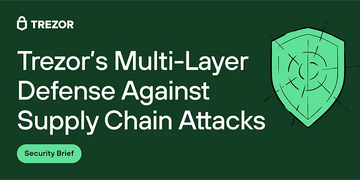There’s a problem with the way we talk about storing our crypto… it’s just too complicated!
In this post, we’ll explain why Trezor has redefined our terminology and what that means for you.
Key takeaways:
- A wallet backup is an ordered list of English words that represent your private key. They contain all the information needed to recover your wallet.
- We now refer to ordered lists of 12, 20, or 24 words as a wallet backup, rather than “recovery seed” or “seed phrase.” We chose to use this term to simplify the process for newer Trezor users.
Key reasons for the change
Less jargon, more clarity
- Terms like “seed phrase” or “recovery seed” are technical and can be confusing, especially for people new to self-custody.
- “Wallet backup” immediately explains what it is, a backup of your wallet!
Consistency with “hardware wallet”
- Users buy a hardware wallet to store their crypto, so calling the backup a “wallet backup” makes the connection clearer.
Avoiding misunderstandings
- Some users misunderstood “seed” as something that grows or changes over time, leading to mistakes in wallet recovery. It’s also harder to understand for non-native English speakers.
- “Wallet backup” reinforces that it’s a fixed, unchangeable list of words that must be kept safe.
Better user experience
- When the term is easy to understand, new users are more likely to take action and properly secure their wallet backup!
If you self-custody your crypto (or are planning on soon), you’ve probably heard these terms before:
• BIP-39 seed phrase
• Mnemonic phrase
• Recovery phrase
• Recovery seed
• Seed phrase
• Backup
• Seed

The good news? They all mean the same thing! But for new users, this terminology can be confusing when securing their assets.
At Trezor, we previously used the term “recovery seed.” However, after seeing firsthand how it caused confusion, we decided to simplify it.
Because honestly, how many new people can understand what a “seed phrase” is? It’s not intuitive, especially when the device we use to secure your crypto is called a hardware wallet. It’s easy to get lost in jargon, which only delays taking control of your crypto!
Introducing the term “wallet backup”!

It’s exactly what it sounds like. If you lose your device and need to recover your wallet, use your wallet backup.
Our wallet backup can look like this:

Or this:

Even this:

(We’ll explain this below!)
What is a wallet backup, really?
Think of your wallet backup as the key or master password to your crypto wallet.
If your Trezor hardware wallet is damaged, you’ll need this wallet backup to recover your funds. Without it, you cannot access, transfer, or manage your funds.
It should be kept in a safe place because without it, you could be permanently locked out of your crypto.
(Watch this video to learn how to keep your wallet backup safe)
Why is my wallet backup a list of words?
When setting up a new wallet, you’ll be asked to write down a list of 12, 20, or 24-word words.
This list of words, generated by your hardware wallet, is your wallet backup. It represents a private key that grants access to your wallet, which holds your assets securely on the blockchain.
“But what about that crazy list of numbers above? Is that also my wallet backup?”
Here’s a fun fact… your wallet backup doesn’t actually start as a list of words!
It originates as a long, random string of mathematically derived characters, which is then converted into words to make it human-readable… crazy, huh?
Another fun fact: Trezor’s founders pioneered this approach!
Once we found a way to translate private key data into simple words, it became the industry standard.
(Just another reason to choose Trezor… humble brag 😉)
Summary: What you need to know about your wallet backup
- Trezor now uses “wallet backup” instead of “recovery seed” to make the concept more user-friendly and understandable.
- Your wallet backup is an ordered list of 12, 20, or 24 words. These must be written down exactly in order to recover your assets.
- Keep your wallet backup private and offline. Anyone with access to it can control your Bitcoin.
- A safe wallet backup ensures you can recover your crypto if your device is lost or damaged.
Until next time,
The Trezor Team
Useful Wallet Backup Articles
- How to use a wallet backup
- 12 vs 24 word wallet backup
- 20-word wallet backup — your questions answered
Thanks for reading! If you enjoyed this article, give it a clap (or a few!) and drop a comment below — we’d love to hear your thoughts. Don’t forget to follow for more insights and updates on the exciting world of crypto security.
Stay secure, and see you next time!


